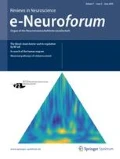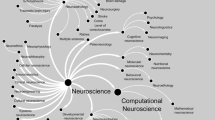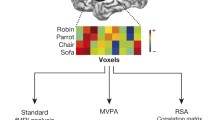Abstract
Studying the human brain remains one of the greatest scientific challenges. A comprehensive understanding of the structural and functional organization of the brain is not only of great importance for basic science, but also for the development of new approaches that improve diagnosis and the treatment of neurological and psychiatric diseases. Thus, the Human Brain Project (HBP) was started in October 2013. The immense complexity of the brain, with its approximately 86 billion nerve cells, makes it essential to include modeling and simulation approaches, combined with methods of high performance computing (HPC), in order to analyze the organizational principles of the brain. Conversely, the understanding of neural mechanisms might inspire new advancements for HPC. The project will be funded with approximately € 1.19 billion, with 75 % of funding from the EU, and the rest provided by partner countries and their institutions. The HBP currently involves about 80 institutions from 22 countries and has a duration of 10 years, thus, making it one of the world’s largest research initiatives. This article is designed to give a brief overview of the HBP organization, and to illustrate the German neuroscientific contributions to the HBP and indicate the relationship to other projects within the HBP.



Similar content being viewed by others
References
Amunts K, Lenzen M, Friederici AD et al (2010) Broca’s region: novel organizational principles and multiple receptor mapping. PLoS Biol 8(9):e1000489
Amunts K, Lepage C, Borgeat L et al (2013) BigBrain: an ultrahigh-resolution 3D human brain model. Science 340(6139):1472–1475
Axer M, Amunts K, Grässel D et al (2011) A novel approach to the human connectome: ultra-high resolution mapping of fiber tracts in the brain. Neuroimage 54(2):1091–1101
Axer M, Graessel D, Kleiner M et al (2011) High-resolution fiber tract reconstruction in the human brain by means of three-dimensional polarized light imaging. Front Neuroinform 5:1–13
Da Monta B, Fritsch V, Varoquaux G et al (2013) Enhancing the reproducibility of group analysis with randomized brain parcellations. In: MICCAI—16th International Conference on Medical Image Computing and Computer Assisted Intervention- 2013, Nagoya, Japan
DeFelipe J (2011) The evolution of the brain, the human nature of cortical circuits, and intellectual creativity. Front Neuroanat 5:29
Dehaene-Lambertz G, Hertz-Pannier L, Dubois J (2006) Nature and nurture in language acquisition: anatomical and functional brain-imaging studies in infants. Trends Neurosci 29(7):367–373
Eger E, Pinel P, Dehaene S, Kleinschmidt A (2013) Spatially invariant coding of numerical information in functionally defined subregions of human parietal cortex. Cereb Cortex
Evans AC, Janke AL, Collins DL, Baillet S (2012) Brain templates and atlases. Neuroimage 62(2):911–922
Hänel C, Pieperhoff P, Henschtel B et al (2014) Interactive 3D visualization of structural changes in the brain of a person with corticobasal syndrome. Front Neuroanat (in press)
Knoll A, Röhrbein F (eds) Front Neuroinform
Kunkel S, Potjans TC, Eppler JM et al (2012) Meeting the memory challenges of brain-scale network simulation. Front Neuroinform 5:35
Mangin JF, Fillard P, Cointepas Y et al (2013) Towards global tractography. Neuroimage 80:290– 296
Marchiori A, Capece L, Giorgetti A et al (2013) Coarse-grained/molecular mechanics of the TAS2R38 bitter taste receptor: experimentally-validated detailed structural prediction of agonist binding. PLoS One 8(5):e64675
Palomero-Gallagher N, Zilles K, Schleicher A, Vogt BA (2013) Cyto- and receptor architecture of area 32 in human and macaque brains. J Comp Neurol 521:3272–3286
Potjans W, Diesmann M, Morrison A (2011) An imperfect dopaminergic error signal can drive temporal-difference learning. PLoS Comput Biol 7(5):e1001133
Rehme AK, Eickhoff SB, Grefkes C (2013) State-dependent differences between functional and effective connectivity of the human cortical motor system. Neuroimage 67:237–246
Torre E, Picado-Muino D, Denker M et al (2013) Statistical evaluation of synchronous spike patterns extracted by frequent item set mining. Front Comput Neurosci 7:132
Zilles K, Schleicher A, Palomero-Gallagher N, Amunts K (2002) Quantitative analysis of cyto- and receptor architecture of the human brain. In: Mazziotta JC, Toga A (eds) Brain mapping: the methods. Elsevier, Amsterdam, pp 573–602
Zilles K, Amunts K (2010) Centenary of Brodmann’s map-conception and fate. Nat Rev Neurosci 11(2):139–145
Compliance with ethical guidelines
Conflict of interest. K. Amunts, A. Lindner, and K. Zilles state that there are no conflicts of interest. The accompanying manuscript does not include studies on humans or animals.
Author information
Authors and Affiliations
Corresponding author
Rights and permissions
About this article
Cite this article
Amunts, K., Lindner, A. & Zilles, K. The human brain project: neuroscience perspectives and German contributions. e-Neuroforum 5, 43–50 (2014). https://doi.org/10.1007/s13295-014-0058-4
Published:
Issue Date:
DOI: https://doi.org/10.1007/s13295-014-0058-4




